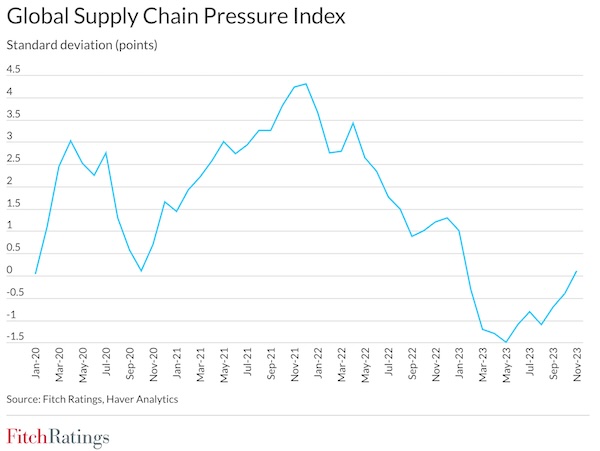Re-routing ships around Africa and away from the Suez Canal following attacks on commercial vessels in the Red Sea adds costs for shipping companies, Fitch Ratings says, but these are likely to be more than offset by rising freight rates if disruptions continue for more than a few days.
Container shipping is likely to see the largest freight rate increases, followed by bulk carriers. Tankers, many of which originate from the Middle East, are already enjoying high rates so rises may be limited. Air cargo rates may also benefit from demand for time-sensitive shipments.
About 50 ships a day pass through the Suez Canal, evenly split between container ships, tankers and bulkers. We estimate that 25%-30% of global container shipping volumes pass through the Suez Canal. Most of them serve trade between Europe and Asia (including Indian and Middle Eastern destinations).

The largest container shippers, including Maersk and Hapag Lloyd, and some oil companies have announced re-routing of ships. Some shippers have also introduced surcharges for using routes to or from the Middle East, for shipments between Europe and Asia or calling on the ports in the region. News reports suggest that vessel traffic through the Canal is down by about a third in the past few days from its normal levels.
Re-routing around Africa can increase travel time from the Far East to Europe by 50%, which could reduce effective global container shipping capacity by 10%-15%. Container ships could increase vessel speed and reduce the number of port calls to counteract longer routes. Current levels of idle capacity are already low. However, we do not expect disruptions to last long enough to have a meaningful impact on global shipping’s supply-demand balance in the medium term. Furthermore, not all container ships are being diverted from Suez. We still expect supply of container shipping capacity in 2024 to outstrip demand growth by about 4pp.
The disruptions may increase annual container contract rates for the affected routes if they last for more than two quarters, which is unlikely in our view. Such rates are usually re-set in the first half of the year. The importance of the Red Sea passage is globally recognised and a US-led military coalition is being put in place to create a safe corridor, which supports our view that the disruptions are unlikely to be sustained.

The current disruptions and re-routing can be compared with port congestion issues in 2021-2022, including a ship blocking the Suez Canal for six days in 2021, when container freight rates increased as much as four times compared to their long-term averages. There are several differences, including the current re-routing implying higher operating costs and the greater certainty of arrival times than during port-congestion issues in 2021-2022. Demand for goods is also not as strong in North America and Europe as it was in 2020-2022.
The Red Sea disruptions amplify the impact on global trade from the Panama Canal congestion, caused by drought conditions that have almost halved the number of vessels using the waterway. Bulkers carrying agricultural commodities and tankers are most affected by the Panama congestion. These shipping issues highlight bottlenecks in global supply chains that can have outsized effects on various industries. The Global Supply Chain Pressure Index is yet to fully reflect these disruptions.
Source: Fitch Ratings